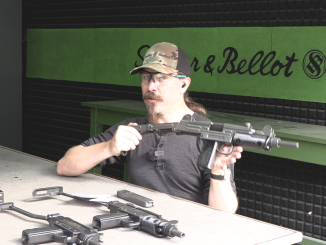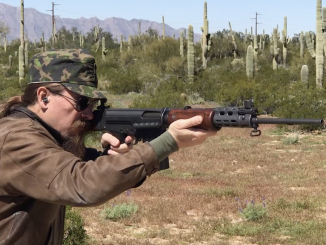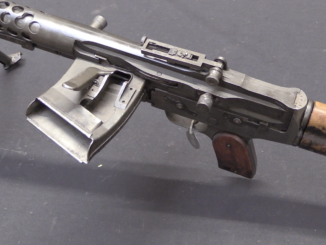After yesterday’s look at the history and mechanical details of the Israeli Negev LMG, today we are taking it out the the range.
It certainly is a very pleasant experience to shoot! The recoil is very light, although not as light as in a true constant-recoil system like the new Knight’s LAMG. As you can see in the high speed footage, the bolt carrier clearly does impact the back of the receiver with each shot. Still, it has a simple gas adjustment, a very easy barrel-changing system, excellent sights, and runs well on both magazines and belts.
Many thanks to Movie Armaments Group in Toronto for the opportunity to showcase their Negev for you! Check them out on Instagram to see many of the guns in their extensive collection.




I noticed that the magazine oscillating front to back in the super slow motion video. When you used the M-16 conversion did it do the same thing?
Impressive! I’m very certain that the magazine-feed functionality was certainly a plus when the user has yet to restock on belts. As our friend Daweo would say, a firearm is a SYSTEM when viewed from design perspective. If you change one component’s properties such that performance of the overall firing cycle would not act the same if said properties were left alone, the rest of the assembly must also change to accommodate the new properties. Looks like the Israelis got it right…
What happens when Private Moses sticks a belt in it while there’s a loaded mag already on it? And where is the bottle opener?
If Private Moses tries to stick a belt in the thing, he’ll get blocked. Do you think the designers wouldn’t see that coming?
Never underestimate Private Moses! Never overestimate designers! I’m going to watch the disassembly again. Yes, I suspect they considered it…but how does it manifest? Will PM be tempted to beat the top cover shut, does it close and double feed into a jam, or is this impossible?
[OFF-TOPIC SO IGNORE IF YOU WISH]
According to https://www.militarytimes.com/off-duty/gearscout/irons/2019/06/12/heckler-koch-maker-of-the-marine-corps-m27-is-in-dire-straits/
Should H&K lose out on the German G36 replacement contract, this could spell the end for the 71 year-old German small arms producer, and a potentially new beginning for a restructured company in its place.
Is that true? So far I know their weapon (HK416) not so far, was chosen by Armée de Terre as default rifle. MP5 seems also to be seller (however maybe that is just my wrong impression?). So why situation of H&K is so hard, if they are able to sell? Or they are not?
In absence of knowing the actual background, when I checked ownership of company couple of years ago there were 2 owners, one of them living in England. None of them had German sounding name. Lately there appeared to be change. I hope you can google out more. You can only guess there is an awful heap of politics in it. Leaches of all kinds see opportunity.
Seeing as the whole G36 scandal was cooked up to simultaneously defame the evul arms maker for political points in Germany and also dump yet another dumptruck full of cash to keep the crippled company afloat for strategic reasons…
The German government (and people) don’t want HK selling guns to civilians, period, or even to governments they don’t absolutely love, so the company basically can’t sell much of anything to anyone outside Germany these days (handguns are basically the exception, for now). HK management would likewise be perfectly content to sell to only LEO/MIL forces in Germany or around Europe…except that none of those nations are willing to pay enough to keep all the overhead in place to make the arms. So HK is caught in a difficult position, probably not much different than FAMAS/Manhurin/CETME/many other European state gunmakers before they went bankrupt. HK will continue to stagnate in this financially stressed condition, until the political timing doesn’t line up in time to get them the next bailout they need before shutting down, at which point there will be no political will to start them up again. Germany will simply buy its guns elsewhere, same as everyone else who ran their arms industry into the ground.
Now we can see what “integrated dynamics” are about. Steady as rock.
“(…)Steady(…)”
Taking in account that this weapon is over 7 kg heavy and firing 5,56×45 NATO (designed to be provide low recoil in much lighter system) I would say that is not surprising.
What surprised me, is small difference of mass between NEGEV for 5,56 mm cartridge and NEGEV for 7,62 mm cartridge. Taking data from Modern Firearms it is respectively 7,4 kg and 7,6 kg (for basic version of both weapons). Exact number varies depending on source for example https://iwi.net/negev/ states 7,6 kg and 7,95 kg but it is always small difference.
This is quite mind-boggling for me as these cartridge are of noticeable different sizes.
Naturally it is possible to carry more 5,56 mm cartridges than 7,62 mm, but second provide greater reach, so I wonder: are NEGEV in 5,56 mm and NEGEV in 7,62 mm used alongside each other in some country? If so how they are distributed among small units?
Yes, similarity of both is noteworthy as much as is their suitability to fire in nearly any stance. I have seen video from factory range which confirms it. What impresses me most is reliable feed which eschews with previous unnecessarily complex top cover-feed type.
Not pretending to know all clues behind its nearly wonderous performance I can see though that the clever integration of elastomeric buffer. https://en.wikipedia.org/wiki/Elastomer
Like the HK LMGs of earlier times, looks like they designed the 7.62mm first, then scaled down only the parts needed for a 5.56mm version. In that case, HK almost certainly was making arguments to buyers about being able to switch calibers in an emergency. Considering the weight of 5.56mm-only LMGs of recent times like the Ultimax, a purpose-built 5.56 Negev might have been a lot lighter, with the usual consequences.
@Ian, you seem to have a strong prejudice against M249 / Minimi, do you ever shoot one ?
Pre-judice or post-judice?
Let him say it. I like to hear it too.
The M249 deserves a lot of the dislike it gets, but the reasons aren’t entirely of either FN or the weapon itself. The US Army created a lot of them with the initial specs, and the incoherent fielding thereof. Oh, and the failure to treat the guns as though they were what they were, essentially disposable machineguns.
The initial M249 was derived from an earlier attempt by FN to produce a lightened MAG58. Doing that, they basically went a little too light, and the receivers were lighter gauge than they should have been. Plus, FN was not used to working in stampings, soooo… Yeah. You want to see how to build a stamped MG, look at either the MG42 or the PK family. What FN did isn’t the way to do it.
The M249 is a great weapon, so long as you’re firing one that is below the threshold of rounds fired, and has been maintained properly. Also, not had the ever-loving spit beaten out of it…
Yet another issue with these guns, as issued and operated here in the US is this: Break-Free is the devil incarnate, when you’re talking MG use thereof. The M249 exhibits a lot of the same issues that the M60 does, in terms of accelerated wear due to the complete absence of viscous cushioning effect from Break-Free. Run those guns on LSA, and they’re much happier, last longer, and don’t show the effects of wear anywhere near as much.
Had they kept Break-Free solely for use on the M16/M4, the M249 would have a much better reputation than it has.
All that said, I think I’d rather have the Negev, the SS-77, or the Knights Armament gun in my squads. The MINIMI is basically the minimum support weapon of the current available guns–It was top of the heap, back when we adopted it, but the state of the art has progressed considerably. I don’t think it would win, were we to hold that competition today.
The expended brass looks like it takes a real beating from the deflector.
I had the opportunity to shoot both the Negev and NG7 side by side a couple years ago at the vendor demo day on the last day of the USASOC sniper competition. IWI normally attends and lets you run a belt through each.
Personally, I found the NG7 easier to shoot accurately since the rate of fire is a little slower. I also got to use the magazine feed on the Negev. Interestingly, I had no less than five malfunctions in 30 rounds, despite the correct gas setting. It’s only a sample of one, but the Negev magazine feed doesn’t inspire much confidence.
Negev magazine… is it not the same as Galil’s? They were solid, made out of steel.
Of course it’s an open bolt, quick-change barrel iron, built to fight dust and sand (and hence probably loose in places), but, being brought up the way I was, I’d like to see what kind of groups it’ll shoot, off the bipod and off a proper padded rest. Semi auto, of course; I don’t expect miracles. I also if the dual-feed feature is worth the effort. Is there any example of a mag-and-belt LMG out there that’s considered reliable?
Here is video of HK MG4 for comparison. It blasts away like there is no tomorrow – https://www.youtube.com/watch?v=NRU3ATXGxuU
Of course, Germans do not do shortcuts – this one has all bells and whistles (minus box mag feed provision), just like all HK arms and quality to go with it.
I think that is one of the biggest pros of the MG4. No magazine feed. It adds complication with not much actual utility, but adds problems and weight. And of course as pretty much the youngest 5,56 machinegun the engineers at H&K could take notes from all the other designs and take the best pieces. It also has constant recoil like the Ultimax. The barrel can be taken off anytime bolt forward or back does nt matter. The only thing I personally really dislike after havong handled and fired one a bit is the mounting for the belt box. To employ the downward ejection it is mounted off to the left side, making it uncomfortable on foot patrol.
Its bigger brother MG5 has its own problems that Kirk could probably go on for pages. 😉 It has problems with durability, the bolt carrier is too heavy, because the Bundeswehr wanted a lower rate of fire (cue Kirk talking about Mg rate of fire and doctrine) and the mounting fits MG3 mountings, but the MG5 is higher than teh MG3, so it cannot replace it in most vehicle mountings. e.g. coaxial in a Leopard 2 or Marder. So basically only roof mounts or tripods.
I see someone knows my triggers…
Actually, I don’t know much about the MG5, past what the specs say. I do find it ironic that the German Army has apparently forgotten everything it knew about machineguns and their own doctrine, because the MG5 clearly isn’t a German design; it’s more what HK would have built for we Americans.
Ah, well… Someday, someone will figure it all out. I’m an agnostic when it comes to the how and the why we all do things, but I do like them to, y’know… Work. And, be consistent. German machinegunnery from about 1939 until recently was a light in the dark, so far as that went. I’m sad to see them extinguish that candle themselves, TBH. It’d be one thing if it had been imposed, but to shoot yourself in the figurative foot…? Sad. Just… Sad.
Wise words!
“specs say(…)MG5 clearly isn’t a German design”
I just looked at that:
https://modernfirearms.net/en/machineguns/germany-machineguns/hk-121-mg-5-eng/
and compared it with previous Bundeswehr machine gun namely MG3:
https://modernfirearms.net/en/machineguns/germany-machineguns/mg-42-i-mg-3-eng/
and to my surprise it is heavier – 11,6 kg vs 10,5 kg without providing any clear advantages over it. So indeed it looks that Germans somewhat ignore effectiveness for which they give attention earlier. Mind-boggling. Is at least MG5 cheaper?
Overall, though… I do have to wonder if the whole concept of a belt-fed support weapon in the same caliber as the individual weapon is all that great an idea.
The Marines are moving away from it, as are the British. Soviets, then Russians did the same. Effectively, I have to wonder if the loss of flexibility and mobility is really justified by the extra firepower one gains from a belt feed, and if that tradeoff shouldn’t be extended to get a heavier caliber, as well…?
Tactically, I think I’d be looking at the things I need that MG to do, like punch through cover and concealment. Even light brush you can see through will cause issues for most 5.56mm rounds, so the utility they have is restricted to open terrain. Any cover or concealment to be had, and you’d better be firing a grown-up caliber at the target.
Then, there’s the itty-bitty problem of effect, down range: Can a hail of 5.56mm do the same job that 7.62mm can, and are the trade-offs you get in terms of delivered projectile weight/ammo at the gun weight worthwhile?
Say you have to fire 18 rounds of 5.56mm to get the same anti-material and anti-personnel effect that you get with nine rounds of 7.62mm? Where then, are your benefits in weight?
I honestly think that we look at most of this from an entirely ass-forwards point of view: Don’t worry about the gun, look at the effect down range. What do you need in that beaten zone? Who cares how it gets there; what do you need in terms of effect down there? Are you getting the same results with fewer projectiles? Do the larger projectiles create more effect, penetrate cover and concealment better?
Design from the beaten zone backwards, I say. That’s what the pre-WWII German Army did, and that’s why the MG34/42 looked the way they did.
“(…)The Marines are moving away from it, as are the British. Soviets, then Russians did the same.(…)”
Well, ЗиД developed КОРД-5,45, see video:
https://www.kalashnikov.ru/kombinirovannoe-udovolstvie-pulemyot-kord-5-45/
combined-feed weapon firing 5,45×39. Often it was exposed to military, colonel of Ministry of Defense noted that: taking in account principal advantages of 7,62-mm rifle cartridge (7,62×54 R) over 5,45×39 mm in area of effective range and penetration, I do not see sense in 7 kg heavy 5,45-mm caliber weapon, when ЗиД itself offers improved PKM which with short barrel is bit more than 8 kg heavy
So, taking in account masses it is not surprising that RPK-16 meet more enthusiasm:
https://modernfirearms.net/en/machineguns/russia-machineguns/rpk-16-eng/
Daweo, I would like to hear your opinion on the ОЦ-128 in 7,61×51. Thanks!
“ОЦ-128 in 7,61×51”
So far: ephemeral.
Only few photos, wit these:
https://www.kalashnikov.ru/po-motivam-alatau-pulemyot-ots-128/
most commonly repeated and only tidbits of information (folding stock, less manipulation required during loading of unit with cartridges than loading belt into “normal” belt-fed weapon so bigger practical Rate-of-Fire) and very few “hard” data – 7,62×51 NATO cartridge, around 20 000 shots fired from shown example.
So it is hard to assess that weapon, as I do not know even such basics as it overall mass or how barrel swaps procedure looks like. Nonetheless I would not be surprised if it would fall into oblivion, as it is extremely unlikely that Russian would replace 7,62×54 R with 7,62×51 NATO cartridge.
It is worth emphasis that reason of creation of this machine gun (why it was made? what tasks it should full-fill? specific limitations regarding final product? potential users?) is not known.
Thank you very much for the prompt reply. Your answer echoes my own thoughts about this new machine gun. Same photos published here and there, and very scant data and details on the gun itself.
I would very much love to know more – basic “hard” data, as you said – on it. What really puzzles me about this design is the use of 7.61×51 NATO round. Is this an indication of export potential as the major drive behind this effort by the prospective manufacturer? I guess the design is still not fully perfected.
Is negev lmg is a gas operated ?